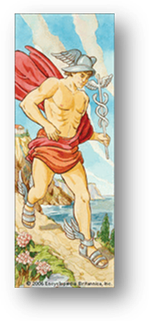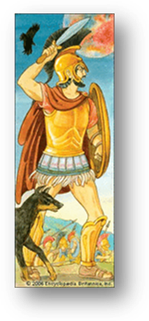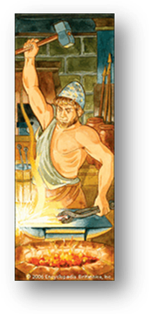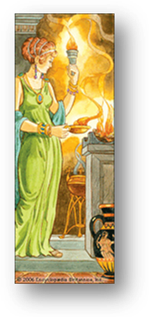HERMES, ARES,
HEPHAESTUS, AND HESTIA
Unit Overview
In
this unit, you will learn about Hermes, Ares, Hephaestus, and Hestia. All three of these gods and goddesses played important
roles in Olympus, but not necessarily important roles in literature.
Hermes
Hermes
was Zeus’ messenger. His father was
Zeus, and his mother was Maia. He wore
winged sandals on his feet, and there were also wings on his helmet. He carried a magic wand called the caduceus. He was shrewd,
or sharp. He was also considered to be a
master thief. Hermes was the patron of
boundaries and of the travelers who cross them.
He watched out for shepherds and cowherds. He favored literature and poets. He was the patron of weights and measures, of
invention, and of general commerce. His
symbols include the tortoise, the rooster, winged sandals, and the caduceus
(shown below).
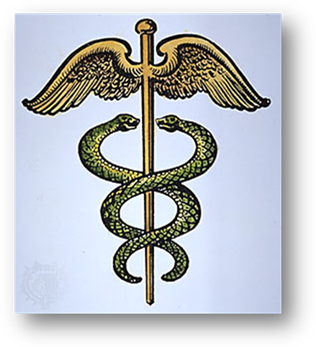
Although
these details portray Hermes as fun-loving and smart, he had another job that
was a serious contrast. He was the guide
of the dead who led souls to the Underworld.
He is one of the few gods who can enter and exit the Underworld.
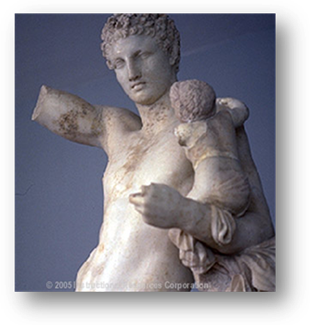
Hermes
was special from the day he was born. He
was born on Mount Cyllene in Arcadia.
His mother, Maia, was also the daughter of Atlas, the Titan. The
daughters of Atlas were called the Pleiades. Maia was a nymph. Maia and Hermes, in
addition to the other Pleiades, were taking refuge in a cave of Mount Cyleene
in Arcadia. She and Hermes were
discovered by Acacus, the local king. He
raised Hermes as his own son.
On
Hermes’ first day, he invented the lyre,
or stringed instrument made from a turtle shell. By nightfall on his first day, he had rustled
the immortal cattle of Apollo. Hermes
drove the cattle back to Apofalfa and hid them.
He covered their tracks by shodding,
or shoeing, the cattle with horses’ shoes.
When Apollo accused Hermes of stealing his cattle, they went to the
courts of the gods so that Zeus would be the one to rule on the decision. Hermes claimed that he stole the cattle in
order to have milk to drink. He offered
the lyre to Apollo, his half brother, and he returned the cattle.
Pan
is often said to be the son of Hermes and the nymph Dryope. It was said that Dryope ran away from Pan
after she gave birth to him because of his goat-like appearance.
Ares
Ares
was the god of war. He was the son of
Zeus and Hera. Ares, however, was
detested by both of his parents. Several
works of Ancient Greek literature express that heroes occasionally rejoiced in
the delight of battle, but most of the time they were glad to have escaped the
fury of the “ruthless god.” Ares is
referred to as murderous, bloodstained, and a coward who runs away when
wounded. He had a quadriga (pictured below), which is a chariot that was drawn by
four golden bridled fire emitting immortal stallions, and he wore bronze
armor.
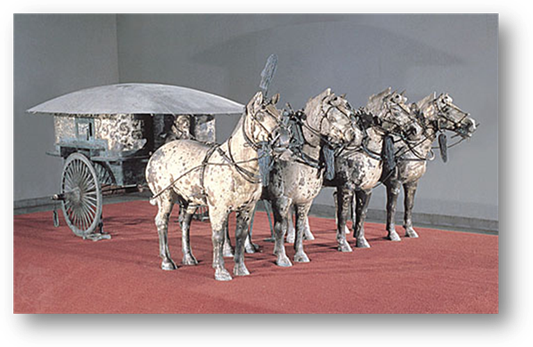
There
are other deities who accompany Ares to the battlefield. They include Eris, his sister and her son,
Strife. Enyo, the goddess of war, is
also present on the battlefield with Ares.
Terror, Trembling, and Panic are also present.
Ares
plays a small part in the literature aspect of mythology. In one story, he is portrayed as the love
interest of Aphrodite, and he is held up to the contempt of the Olympians by
Hephaestus. For the majority of
literature, he is little more than the symbol of war. He does not have a distinct personality like
the other Olympians.
Once,
Helios, the sun god, saw Ares and Aphrodite together in the hall of
Hephaestus. Helios immediately reported
what he saw to Hephaestus, Aphrodite’s husband.
Hephaestus decided that he would catch the two of them together. He made a net with which he planned on
catching the two together.
Ares
and Aphrodite were captured in Hephaestus’ net.
Just catching the two of them, however, was not enough. Hephaestus invited the other Olympians to
view the two together. The goddesses
declined this invitation, wanting to remain modest. The gods, however, went to view the two of
them trapped in the net. Many of the
gods agreed that they would trade places with Ares because of Aphrodite’s
beauty. They mocked the two as they
passed the net. Eventually, they were
set free and Ares left quickly because he was embarrassed.
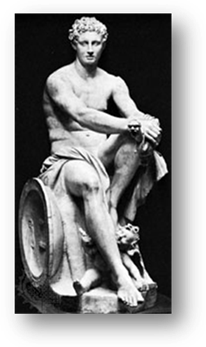
In
the Iliad, Ares has no alliances or respect for the order of things. First, he promised Athena and Hera that he
would fight on the side of the Achaeans.
Aphrodite was then able to persuade Ares to fight for the Trojans. During the war, Diomedes fought with Hector
and saw Ares fighting on the Trojans’ side.
Diomedes called for his soldiers to fall back slowly. Hera, Ares’ mother, saw her son’s
interference. She asked Zeus for
permission to drive Ares away from the battlefield. Hera even encouraged Diomedes to attack Ares. Diomedes threw a spear at Ares. His cries made the Achaeans and Trojans
tremble. Athena then drove a spear into
Ares’ body. He fled in pain. This forced the Trojans to retreat. Later, Zeus allowed Ares to fight in the war
again. Ares tried to fight Athena to
avenge himself the previous injury. Ares
was able to overpower Athena by throwing a large boulder at her.
Ares
has no cities where he is worshiped. His
bird was the vulture. The dog was his
animal, which is considered odd by some because dogs are thought to have been
loyal and loving toward man.
Hephaestus
Hephaestus
is the god of fire. He is sometimes said
to have been the son of Zeus and Hera.
Other stories say that Hera bore Hephaestus alone as retaliation for
Zeus carrying Athena alone. Hephaestus
is the only deity that is considered ugly.
This is odd among the other Olympians because they are considered to be
very handsome and beautiful individuals.
Hephaestus is lame as well. His
status at Mt. Olympus is debated; the Iliad says that Hera cast him out of
Olympus. In the Odyssey, Hephaestus is
honored at Mt. Olympus because he is the workman.
The
responsibilities of Hephaestus included making dwellings, furnishings, and
weapons. In his workshop, he had
handmaidens forged out of gold that moved about and helped with his work. Hephaestus is also considered the god of
technology, blacksmiths, craftsmen, artisans, sculptors, metals, metallurgy,
fire, and volcanoes. His symbols are the
smith’s hammer, an anvil, and a pair of tongs.
Sometimes, he is portrayed holding an axe.
Hephaestus
was a kind, peace-loving god. He was
popular on earth and at Mt. Olympus. He
was important to life in the city. He was worshiped in the manufacturing and
industrial centers of Greece, particularly in Athens. He was a patron of handicrafts and the
arts. He was the protector of the
blacksmiths. When children were formally
admitted to the city organization, the god of the ceremony was Hephaestus.
Hephaestus
was responsible for creating a lot of the equipment used by the gods. He created Hermes’ winged helmet and
sandals. He made Achilles’ armor, Eros’
bow and arrows, the Aegis, and Aphrodite’s girdle, to name a few.
His
wife is another topic of debate. In the
Iliad, his wife is one of the three Graces.
In the Odyssey, his wife is Aphrodite.
The previous story about Hephaestus catching Ares and Aphrodite in a net
shows that Aphrodite was not always a faithful wife. Zeus gave her hand in marriage to Hephaestus
because Zeus was worried about conflict.
Zeus thought that Aphrodite’s beauty would cause conflict between the
other gods. After Hephaestus caught Ares
and Aphrodite together, he invited the other gods to look at them. Eventually, Poseidon persuaded Hephaestus to
free them. In exchange, Ares had to pay
an adulterer’s fine.
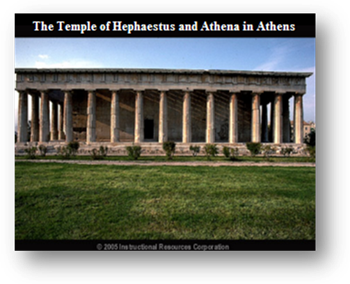
Hestia
Hestia
was Zeus’ sister. She was a maiden
goddess like Athena and Artemis. She had
no distinct personality and plays no part in the myths. She was the goddess of the hearth, which is
the symbol of the home. There was a
tradition that when a newborn baby was born, the baby must first be carried
around the hearth and introduced to Hestia before it could be received into the
family. Every meal began and ended with
an offering to her. Although she had no
children of her own, she was a maternal goddess. Humans, safe in their homes, and wanderers
finding shelter in caves all worshiped her.
Each
city had a public hearth dedicated to Hestia.
At this hearth, the fire was never allowed to go out. If a colony was going to be founded, someone
would carry coals from the hearth of the mother-city. At the site of the new colony, the coals were
deposited in the hearth in order to start the new fire.
Hestia
is described as passive and non-confrontational. Sometimes, it is said that because of these
personal characteristics, she gave up her seat in the Olympian twelve in order
to prevent conflict. Her lack of participation
in myths is sometimes explained because the hearth is immovable. Because the hearth cannot be moved, Hestia
couldn’t take part in the procession of the gods or any of the other activities
the Olympians participated in. Leaving
Olympus made her a lesser goddess.
Poseidon
and Apollo each attempted to court Hestia.
Hestia was not impressed. She
swore on the head of Zeus that she would retain her virginity. Because she swore on the head of Zeus, this
meant that she would remain a maiden.
|
|
Now
answer questions 1 through 38. |
Writing about Literature: The Expository
Paragraph
This
unit introduced Hermes, Ares, Hephaestus, and Hestia, gods and goddesses who did
not play an important role in literature, but who were important to the
Greeks. You will use the information
given in this unit to write an expository paragraph explaining the important
roles these four gods and goddesses played on Mt. Olympus and on Earth.
An
expository paragraph is a paragraph written to explain or to share
information. It is written using a topic
sentence, supporting details, and a conclusion sentence. Linking words such as first, second, next, and
finally are used to help the reader follow the flow of ideas. When writing an expository paragraph, the
author should not mention himself or herself but simply present the facts. Expository paragraphs should be written using
formal language, not informal, everyday vocabulary.
To
prepare to write an expository paragraph, you can use the same prewriting tasks
that you have used in past units. Choose
one of those tasks from the list below.
You will submit your prewriting in the questions section of this unit.
|
Gathering
Information Tasks |
|
|
Brainstorming |
A technique in which you come up
with as many ideas as possible on a subject |
|
Clustering |
A technique in which you break
down a subject into smaller parts – Place the subject in the middle and
circle it. Write related ideas around
the subject, circling them and drawing lines to the subject. |
|
Asking
Questions |
A technique in which these
questions are used to gather information:
Who? What? When?
Where? Why? How? |
|
Direct
Observation |
A
technique in which the writer relies on the five senses – sight, touch,
smell, hearing, tasting. |
|
Indirect
Observation |
A technique in which the writer
examines the experiences of others by asking questions, watching,
interviewing, etc. |
|
Imaging |
A technique in which the writer
uses his imagination to generate ideas |
Once you have completed the prewriting activity, you will need to form your
topic/thesis sentence. This sentence needs
to clearly explain to the reader what is being discussed in the paragraph, and
it should capture the reader’s attention.
After
creating your topic/thesis sentence, write the rough draft of your
paragraph. These sentences should
support your topic/thesis sentence. Each
sentence should contain information that is directly related to your
topic/thesis sentence, and they should be written using formal language.
Follow
the body of your sentence with a conclusion sentence. This sentence should
restate the topic of your paragraph and bring the paragraph to a close. The reader should be left with a sense of
closure.
Since
no paragraph is perfect the first time it is written, you will again be working
through the self-evaluation, revision, and editing processes in the questions
section. Once you have completed these
steps, you will submit your final draft.
|
|
Now
answer questions 39 through 45. |
Applying Learning: Who Do You Choose?
Now
that you’ve learned about many Greek gods and goddesses, choose the one who
most resembles you. You may choose any
god or goddess you have learned about in any unit up to this point. Research the god or goddess to learn even
more about him or her. Keep a list of
the sources that you use for your research, as you will be asked to submit that
list in the questions section of this unit.
After your have completed your research, brainstorm a list of things that you
have in common with the god or goddess you chose. List items such as personality traits, family
structure, and interests. Use this list
to create one of the following projects.
Give
a Speech

Write a speech
describing the similarities between you and the god or goddess you chose. Your speech should be two to three minutes
long, and you should type it using Microsoft Word or another word processing
program. You will be able to record
yourself giving your speech in the questions section of this unit. Click the Add Recording button in question 46,
and follow the on-screen directions for recording your speech. You should speak clearly and slowly, making
sure that your teacher is able to understand each word of your speech.
In addition to
submitting the recording of your speech, you should attach a copy of your
speech to question 46. This will allow
your teacher to read what you have written.
Your written speech should also contain a complete list of the sources
that you used to find information about your topic. If you used a website, you should list the
complete URL (web address) for the site.
Create
a Microsoft PowerPoint Presentation

Create a PowerPoint
presentation describing what you have in common with the god or goddess you
chose. Your slides should include the
following:
·
Slide 1 – Cover Slide
Include the name and picture of the god or goddess and your
name. You may choose to include a picture
of yourself, but it is not required.
·
Slides 2 through 8 – Informational Slides
These slides should describe what you have in common with
the god or goddess you chose. Include items such as
personality traits, family structure, and interests. Each
of these pages should include at least one picture and two or three sentences
about your topic. Sentences should be
complete, and you
should use correct spelling, punctuation, and grammar. Under each picture, type the website where
you found the picture.
·
Slide 9 – Works Cited
This slide should list all
of the sources that you used to find information about your topic. If you used a website, you should list the
complete URL (web address) for the site.
You should also include websites that you used to find pictures.
If you do not
have PowerPoint software on your computer, you may download the free software
OpenOffice (http://www.openoffice.org). It is similar to Microsoft Office, and it has
a presentation tool similar to PowerPoint.
A presentation created using OpenOffice can be opened with your
teacher’s PowerPoint software.
Create
a Windows Movie Maker (or Mac Equivalent) Project

Create a Movie
Maker presentation describing what you have in common with the god or goddess
you chose.
·
Slide 1 – Cover Slide
Include the name and picture of the god or goddess and your
name. You may choose to include a
picture of yourself, but it is not required.
·
Slides 2 through 17 – Informational Slides
Your pages should alternate between pictures and text. For example, slide 2 should be a picture,
slide 3 text, slide 4 a picture, slide 5 text, and so on. To insert text, use the caption feature of
Movie Maker.
For each picture slide, you should add a caption giving the
complete URL (web address) for the site where you found the picture. Each text slide should contain two or three
sentences about your topic. These text
slides should describe what you have in common with the god or goddess you
chose. Include items such as
personality traits, family structure, and interests. Sentences
should be complete, and you should use correct spelling, punctuation, and
grammar.
·
Slide 18 – Works Cited
This slide should list all
of the sources that you used to find information about your topic. If you used a website, you should list the
complete URL (web address) for the site.
You should also include websites that you used to find pictures.
When your
project is complete, you should export it to your computer so that it can be
played back using Windows Media Player or QuickTime. When you send your finished project to your
teacher, only send the exported file, not your original Movie Maker project
file. You may choose to add music in the
background. However, your music choice
should be appropriate for the topic, and all music should be cited on your
Works Cited slide.
If you do not have Windows Movie Maker on your computer, it is available as a free download from Microsoft here.
If
you have another idea for a project to communicate the information, check with
your teacher first. Your project file
will need to be opened by your teacher, so your software must be compatible
with the software that your teacher is using.
If
you do not have access to any of these software tools, please contact your
teacher.
|
|
Now
answer question 46. |
